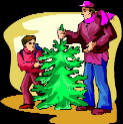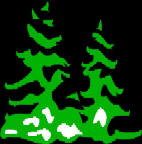Decorating Your Christmas Tree
Tips to create a Designer Family Tree
Decorating the tree varies from the random scattershot of a family-decorated
tree with small children assisting, to the antiseptic precision of a
monochromatic design of an aging dowager. Whatever style your prefer, it
reflects your family's personality!
Here are some designs and tips:
Where to place the tree
Typically, Christmas trees are placed in front of a large window in the living room or family room. If you have small children or pets, you may want choose a room that can be closed off from the rest of the house.
1. Start by setting up the tree away from the wall so you have room to walk around it.
2. Decide which side of the tree looks best to face out to your primary audience.
Lights
How Many Lights Do I Need?
Typically, count on 100 lights per vertical foot of tree. For example: for a 7 foot tree, you will need at least of 700 lights. I prefer 150 per foot (or 1050 lights for a 7 foot tree) for a more "twinkly" look.
Of course, if your tree is fuller than average you will also need more lights than on a slender tree.
Type of lights
The lights come in a staggering variety of colours, shapes, sizes and features. It is simply a matter of your preference and family tradition! Here are some descriptions:
Colours
Most stores carry three colour schemes: white (clear), any other single colour, or mixed (multi-)colours. Some people prefer the "tasteful" look of an all-white tree; others the warmer, more cheerful look of mixed colours, In recent years, manufacturers have produced a number of single colour lines, all blue, all red, etc. As a break from tradition, they can be interesting, too.
Shapes
For many decades, the only shape that was produced was a 1 inch long egg-shaped bulb. Now, there are many to choose from:
Mini - the most common and inexpensive light is about 1/2 inch long and can usually be used indoors or outside. They come in almost every colour scheme.
Shapes - some manufacturers encase their mini-lights in translucent enclosures in themed shapes, such as snowmen, Santa-Clauses, stars, etc.
Bubble lights - These go back at least 50 years. A small light is encased in a base, above which a tube of coloured liquid is placed. When the light heats up, the liquid bubbles inside the tube for a nice effect!
LED lights: this year, the new LED lights, which use much less energy, are brighter, are hard to break and can potentially last a lifetime before wearing out. Of course, they are also 3 times the price of regular light sets!
Flashing and patterns - By placing a single special bulb anywhere in the line, the entire string will flash in union. Other strings have more sophisticated electronics that will cause a twinkling effect. With tiny computer chips, even more elaborate patterns, fade-ins and fade-outs, running effects, etc. are possible, and usually quite inexpensively.
Placing Lights on the Tree
First, test each strand BEFORE you use them - it's hard to diagnose the string while on the tree. Lights go on the tree first, before ornaments, tree toppers or anything else. Plug them in and leave them lit before you start to put them on the tree. Most stores now sell special light test guns, for usually about £20. I haven't tried one yet, but they claim to be able to quickly an deasily test lights while they are still in the string, so you can locate burned out bulbs.
It is easiest to start at the TOP of the tree, putting the receptacle end of the line there in place for your tree topper (star, angle or spike?) Wrap the cord loosely around the branch until you reach the end of the strand, then attach another strand and continue until your reach the bottom. As you go down the tree, run some lights inside the tree to give the tree depth!
Ornaments
Types
Time to go crazy with the ornaments! In addition to the traditional solid thin glass balls, glass shapes, metal ornaments, cards, ribbons, bells and dolls are all great additions to the tree. Some families also use the traditional ornaments of our forefathers: strings of popcorn, cranberries, gold-coloured beads, wire ribbon or bows.
Where to place them
Put the ornaments both at the ends of the branches and inside the tree to reflect the lights and give it more depth. To secure your ornaments on the tree squeeze the wire hanger closed after you've placed the ornament on the tree.
Garland, Tinsel and Icicles
Garlands are strings of tinsel material strung around the tree to give it a "flocked" or snowy look. Tinsel is thin metal foil that gives the effect of icicles. Icicles are plastic replicas of frozen water icicles.
Tree Toppers
Most common in the U.S. (and the classic debate) is the Star or Angel. Some families prefer a huge bow or a glass tree topper (like a spike on a ball)
Tree Bottoms
Don't forget to finish the bottom of the tree with a skirt to catch needles and hide the stand and trunk. Several yards of green or red material can be bunched under the tree for a decorative skirt.
Some people like to run a train around the base of their tree!
Themes and Designs
Tree themes are becoming more popular every year (and now that Martha Stewart is out of prison, I suppose we'll be seeing more Christmas excess! :)
A theme can be any style from a reflection of your hobby, a colour scheme, or a reproduction of historic design. Hobby and craft shops sell many small decorative items that can be used as ornaments to help create the theme.
The bottom line is have fun and make the tree that you and your family enjoy!
 Christmas Tree
Farms, Tree Lots, Hayrides, Sleigh Rides and Other Winter Fun
Christmas Tree
Farms, Tree Lots, Hayrides, Sleigh Rides and Other Winter Fun